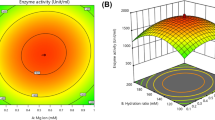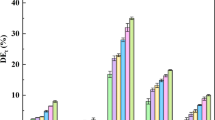Abstract
The biodegradation of nonylphenol (NP) and octylphenol (OP) isomers by laccase has attracted increasing concerns. However, the interaction mechanism between these isomers and laccase remains unclear, especially for fungal laccase. In this work, molecular docking was employed to study this issue. The results indicated that the structural characteristic of alkyl chain (position and branching degree) affected the interactions between Trametes versicolor (T. versicolor) laccase and isomers. The binding affinity between them was closely related to the position and branching degree of alkyl chain in isomers. The binding affinities between linear isomers and T. versicolor laccase were para-position < meta-position < ortho-position. For selected branched 4-NP, the isomers with bulky α-substituent in alkyl chain had higher binding affinities. In addition, hydrophobic contacts between T. versicolor laccase and NP or OP isomers were necessary, while H-bonds were optional. The isomers with similar structure may have more common residues involved in hydrophobic contacts. The H-bonds of selected NPs and OPs were all connected with phenolic hydroxyl. These findings provide an insight into detailed interaction mechanism between T. versicolor laccase and isomers of NP and OP. It is helpful to broaden the knowledge of degradation technology of NPs and OPs and provide theoretical basis on biological remediation of these contaminants.
Graphical Abstract






Similar content being viewed by others
References
Chen M, Xu P, Zeng GM, Yang C, Huang D, Zhang J (2015) Bioremediation of soils contaminated with polycyclic aromatic hydrocarbons, petroleum, pesticides, chlorophenols and heavy metals by composting: applications, microbes and future research needs. Biotechnol Adv 33:745–755
Gasser CA, Ammann EM, Shahgaldian P (2014) Laccases to take on the challenge of emerging organic contaminants in wastewater. Appl Microbiol Biot 98(24):9931–9952
Lai C, Wang MM, Zeng GM, Liu YG, Huang DL, Zhang C, Wu HP (2016) Synthesis of surface molecular imprinted TiO2/graphene photocatalyst and its highly efficient photocatalytic degradation of target pollutant under visible light irradiation. Appl Surf Sci 390:368–376
Wang Z, Yang Y, He T (2015) Change of microbial community structure and functional gene abundance in nonylphenol-degrading sediment. Appl Microbiol Biot 99(7):3259–3268
Zhang C, Lai C, Zeng GM, Huang DL, Yang CP, Wang Y, Zhou YY, Cheng M (2016) Efficacy of carbonaceous nanocomposites for sorbing ionizable antibiotic sulfamethazine from aqueous solution. Water Res 95:103–112
Zeng G, Jia W, Huang D, Liang H, Chao H, Min C (2017) Precipitation, adsorption and rhizosphere effect: the mechanisms for phosphate-induced Pb immobilization in soils—a review. J Hazard Mater 339:354–367
Thomaidi VS, Stasinakis AS, Borova VL, Thomaidis NS (2015) Is there a risk for the aquatic environment due to the existence of emerging organic contaminants in treated domestic wastewater? Greece as a case-study. J Hazard Mater 283:740–747
Zhang C, Zeng GM, Huang DL, Lai C, Huang C, Li NJ, Xu P, Cheng M, Zhou YY, Tang WW, He XX (2014) Combined removal of di (2-ethylhexyl) phthalate (DEHP) and Pb (II) by using a cutinase loaded nanoporous gold-polyethyleneimine adsorbent. RSC Adv 4(98):55511–55518
World Health Organization (2017) Global assessment of the state-of-the-science of endocrine disruptors. In: WHO/PCS/EDC/02.2. World Health Organization, Geneva, Switzerland. http://www.who.int/ipcs/publications/new_issues/endocrine_disruptors/en/. Accessed 23 Sept 2017
European Union (2017) Directive 2013/39/EU of the European parliament and of the council of 12 August 2013 amending Directives 2000/60/EC and 2008/105/EC as regards priority substances in the field of water policy. European Union. http://eur-lex.europa.eu/legal-content/EN/TXT/?qid=1492360604368&uri=CELEX:32013L0039. Accessed 23 Sept 2017
Zenkevich IG, Makarov AA, Schrader S, Moeder M (2009) A new version of an additive scheme for the prediction of gas chromatographic retention indices of the 211 structural isomers of 4-nonylphenol. J Chromatogr A 1216(18):4097–4106
Lu Z, Gan J (2014) Analysis, toxicity, occurrence and biodegradation of nonylphenol isomers: a review. Environ Int 73:334–345
Kim YS, Katase T, Sekine S, Inoue T, Makino M, Uchiyama T, Fujimoto Y, Yamashita N (2004) Variation in estrogenic activity among fractions of a commercial nonylphenol by high performance liquid chromatography. Chemosphere 54(8):1127–1134
Corvini PF, Schaffer A, Schlosser D (2006) Microbial degradation of nonylphenol and other alkylphenols—our evolving view. Appl Microbiol Biotechnol 72(2):223–243
Guenther K, Kleist E, Thiele BB (2006) Estrogen-active nonylphenols from an isomer-specific viewpoint: a systematic numbering system and future trends. Anal Bioanal Chem 384(2):542–546
Zhang H, Zuehlke S, Guenther K, Spiteller M (2007) Enantioselective separation and determination of single nonylphenol isomers. Chemosphere 66(4):594–602
Minussi RC, Pastore GM, Duran N (2007) Laccase induction in fungi and laccase/N-OH mediator systems applied in paper mill effluent. Bioresour Bioresour Technol 98(1):158–164
Zhang C, Liu L, Zeng GM, Huang DL, Lai C, Huang C, Li FL (2014) Utilization of nano-gold tracing technique: study the adsorption and transmission of laccase in mediator-involved enzymatic degradation of lignin during solid-state fermentation. Biochem Eng J 9:149–156
Hu L, Wan J, Zeng GM, Chen A, Chen GQ (2017) Comprehensive evaluation of the cytotoxicity of CdSe/ZnS quantum dots in Phanerochaete chrysosporium by cellular uptake and oxidative stress. Environ Sci Nano. https://doi.org/10.1039/C7EN00517B
Mot AC, Silaghi-Dumitrescu R (2012) Laccases: complex architectures for one-electron oxidations. Biochemistry 77(12):1395–1407
Majeau JA, Brar SK, Tyagi RD (2010) Laccases for removal of recalcitrant and emerging pollutants. Bioresour Bioresour Technol 101(7):2331–2350
Dubroca J, Brault A, Kollmann A, Touton I, Jolivalt C, Kerhoas L, Mougin C (2005) Biotransformation of nonylphenol surfactants in soils amended with contaminated sewage sludges. In: Environmental chemistry: green chemistry and pollutants in ecosystems. Springer, Berlin
Catapane M, Nicolucci C, Menale C, Mita L, Rossi S, Mita DG, Diano N (2013) J Hazard Mater 248:337–346
Tamagawa Y, Hirai H, Kawai S, Nishida T (2007) Environ Toxicol 22(3):281–286
Catherine H, Penninckx M, Frédéric D (2016) Enzymatic removal of estrogenic activity of nonylphenol and octylphenol aqueous solutions by immobilized laccase from Trametes versicolor. Environ Technol Innovat 5:250–266
Huang SL, Ngoc Tuan N, Lee K (2016) Occurrence, human intake and biodegradation of estrogen-like nonylphenols and octylphenols. Curr Drug Metab 17(3):293–302
Chen M, Zeng GM, Tan Z, Jiang M, Li H, Liu L, Zhu Y, Yu Z, Wei Z, Liu Y, Xie G (2011) Understanding lignin-degrading reactions of ligninolytic enzymes: binding affinity and interactional profile. PLoS One 6(9):e25647
Chen M, Qin XS, Zeng GM (2016) Single-walled carbon nanotube release affects the microbial enzyme-catalyzed oxidation processes of organic pollutants and lignin model compounds in nature. Chemosphere 163:217–226
Lavanya P, Ramaia S, Anbarasu A (2016) A molecular docking and dynamics study to screen potent anti-staphylococcal compounds against ceftaroline resistant MRSA. J Cell Biochem 117(2):542–548
Chen M, Zeng GM, Xu P, Zhang Y, Jiang DN, Zhou S (2017) Understanding enzymatic degradation of single-walled carbon nanotubes triggered by functionalization using molecular dynamics simulation. Environ Sci Nano 4:720–727
Zhang Y, Zeng Z, Zeng GM, Liu ZF, Chen M, Liu LF, Li JB, Xie GX (2012) Effect of Triton X-100 on the removal of aqueous phenol by laccase analyzed with a combined approach of experiments and molecular docking. Colloids Surf B 97:7–12
Molegro APS (2011) MVD 5.0 Molegro Virtual Docker. DK-8000 Aarhus C, Denmark
Piontek K, Antorini M, Choinowski T (2002) Crystal structure of a laccase from the fungus Trametes versicolor at 1.90—a resolution containing a full complement of coppers. J Biol Chem 277(40):37663–37669
Guenther K, Kleist E, Thiele B (2006) Estrogen-active nonylphenols from an isomer-specific viewpoint: a systematic numbering system and future trends. Anal Bioanal Chem 384(2):542–546
Dewar MJS, Zoebisch EG, Healy EF, Stewart JJP (1985) AM1: a new general purpose quantum mechanical molecular model. J Am Chem Soc 107:3902–3909
Chen M, Zeng GM, Lai C, Li J, Xu P, Wu H (2015) Molecular basis of laccase bound to lignin: insight from comparative studies on the interaction of Trametes versicolor laccase with various lignin model compounds. RSC Adv 5(65):52307–52313
Thomsen R, Christensen MH (2006) MolDock: a new technique for high-accuracy molecular docking. J Med Chem 49(11):3315–3321
Mercader A, Castro EA, Toropov AA (2001) Maximum topological distances based indices as molecular descriptors for QSPR. 4. Modeling the enthalpy of formation of hydrocarbons from elements. Int J Mol Sci 2(2):121–132
Liu L, Zeng Z, Zeng GM, Chen M, Zhang Y, Zhang J, Fang X, Jiang M, Lu L (2012) Study on binding modes between cellobiose and beta-glucosidases from glycoside hydrolase family 1. Bioorg Med Chem Lett 22(2):837–843
Thomsen R, Christensen M (2011) Molegro Virtual Docker 5.0 User Manual. Molegro APS, Aarhus
Laskowski RA, Swindells MB (2011) LigPlot+: multiple ligand–protein interaction diagrams for drug discovery. J Chem Inf Model 51(10):2778–2786
Jaccard P (1901) Étude comparative de la distribution florale dans une portion des Alpes et des Jura. Bull Soc Vaudoise Sci Nat 37(142):547–579
Sokal R, Michener C (1958) A statistical method for evaluating systematic relationships. Univ Kansas Sci Bull 38:1409–1438
Anstead GM, Carlso KE, Katzenellenbogen JA (1997) The estradiol pharmacophore: ligand structure-estrogen receptor binding affinity relationships and a model for the receptor binding site. Steroids 62(3):268–303
Bonchev D, Trinajstić N (1977) Information theory, distance matrix, and molecular branching. J Chem Phys 67(10):4517–4533
Hao R, Li J, Zhou Y, Cheng S, Zhang Y (2009) Structure-biodegradability relationship of nonylphenol isomers during biological wastewater treatment process. Chemosphere 75(8):987–994
Gabriel FLP, Routledge EJ, Heidlberger A, Rentsch D, Guenther K, Giger W, Sumpter JP, Kohler HPE (2008) Isomer-specific degradation and endocrine disrupting activity of nonylphenols. Environ Sci Technol 42(17):6399–6408
Gabius HJ, André S, Jiménez-Barbero J (2011) From lectin structure to functional glycomics: principles of the sugar code. Trends Biochem Sci 36(6):298–313
Cassidy CE, Setzer WN (2010) Cancer-relevant biochemical targets of cytotoxic Lonchocarpus flavonoids: a molecular docking analysis. J Mol Model 16(2):311–326
Krupiński M, Długoński J (2011) Biodegradacja nonylofenoli przez wybrane drobnoustroje. Post Mikrobiol 50(4):313–319
Acknowledgements
The research was financially supported by the National Natural Science Foundation of China (51521006, 51508177, 51408206, 21407046, and 31470594), the program for New Century Excellent Talents in University (NCET-13-0186), and the Program for Changjiang Scholars and Innovative research Team in University (IRT-13R17).
Author information
Authors and Affiliations
Corresponding authors
Ethics declarations
Conflict of interest
The authors declare that they have no conflict of interest.
Electronic supplementary material
Below is the link to the electronic supplementary material.
Rights and permissions
About this article
Cite this article
Mo, D., Zeng, G., Yuan, X. et al. Molecular docking simulation on the interactions of laccase from Trametes versicolor with nonylphenol and octylphenol isomers. Bioprocess Biosyst Eng 41, 331–343 (2018). https://doi.org/10.1007/s00449-017-1866-z
Received:
Accepted:
Published:
Issue Date:
DOI: https://doi.org/10.1007/s00449-017-1866-z




